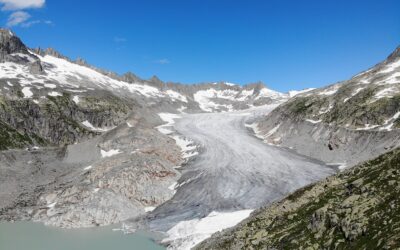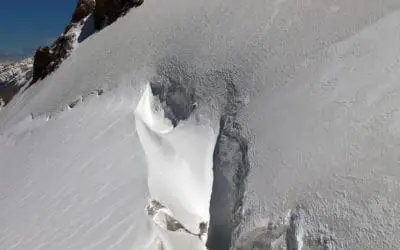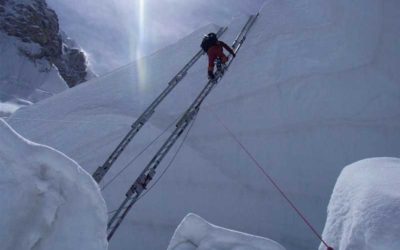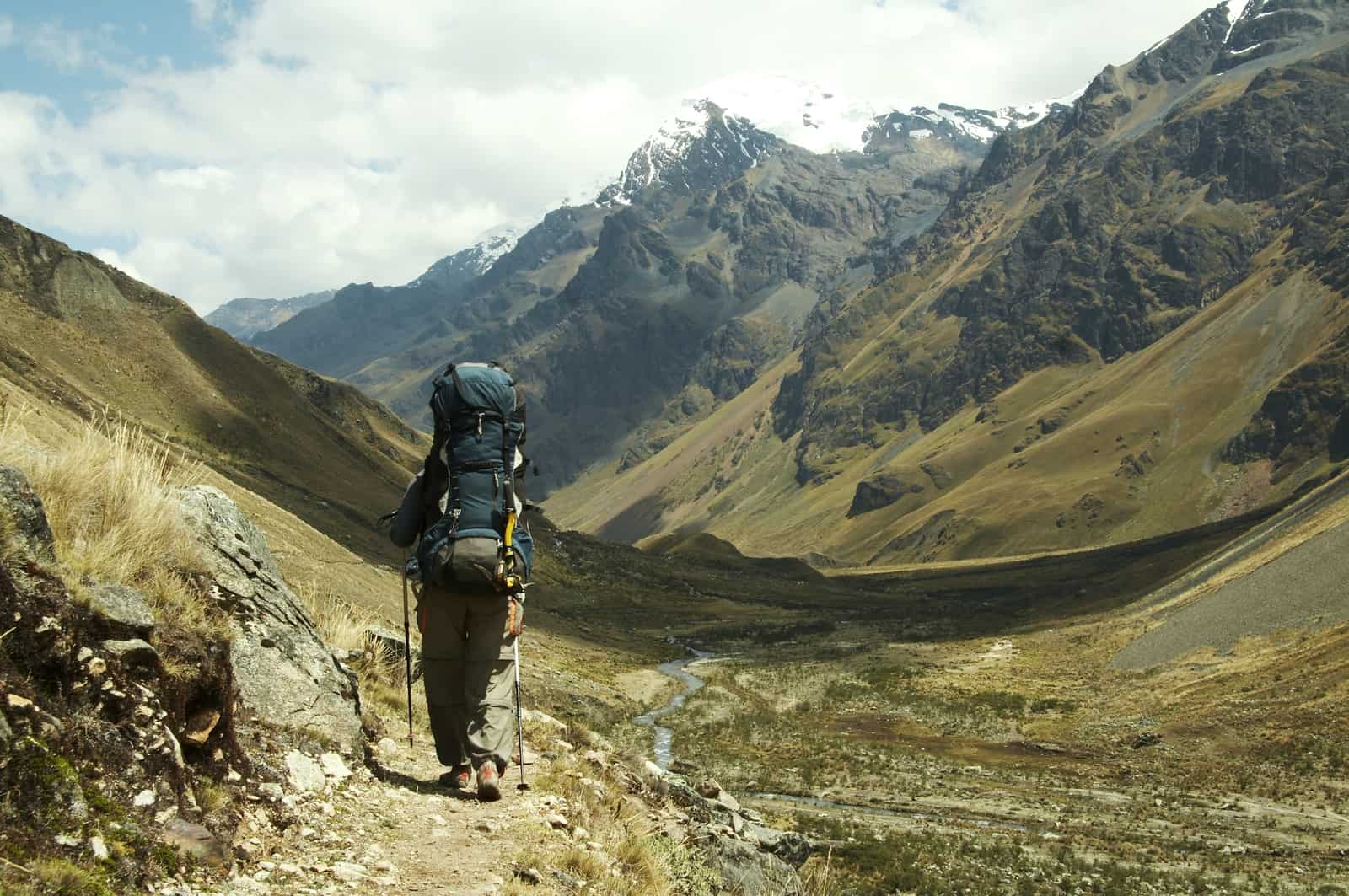
Mountain climbing, also known as mountaineering, is an extremely rewarding sport. It’s also a very expensive (amen to that) and potentially dangerous sport. Knowing where to start will save you considerable headache and frustration. In this guide, I aim to break down the essentials of what you need to know before tackling your first mountaineering expedition. I will also share what I have learnt and would have wanted to learn as I began tackling the mountains.
Contents
Terminology
The terms mountaineering and climbing are often used interchangeably. They’re not exactly the same, though.
Mountaineering refers to walking up a mountain with very little gear and no Alpinist knowledge. Don’t get me wrong, this is not a stroll in the park. The going is very tough, especially at high altitudes. Mountaineering is usually done on snow-free peaks.
Mountain climbing refers to getting over obstacles by scrambling on your hands and knees or using a rope or other gear. In some mountains, there are also some previously installed chains and ladders on the rock face to help you along the way. Italians call this Ferrata-routes, while the Germans call it Eisen-weg.
Equipment
High quality hiking boots are an essential investment for any aspiring mountaineer. These are typically quite expensive, but a good pair can last you quite a few years and will keep your feet safe to walk another day. Choose a pair that you find comfortable, preferably a type that supports your ankle as well. This will minimize sprains, which happens easily on tough terrain.
Don’t purchase a lot of equipment in the beginning. Once you have a good pair of boots, go on a short expedition to see whether you like it or not. Once the bug has bitten, you can invest in more equipment as you feel the need.
Added to your boots, invest in a waterproof jacket and pants. This will keep you dry and warm enough during shorter hikes. Also get a good, comfortable backpack for day trips. In the beginning, you’re not likely to go out for days at a time, so you don’t need all the bells and whistles yet. Find out what you like, go with some experienced friends and add to your gear as you go along.
Choose a Home Base
When you start out, you don’t necessarily want to trek up a mountain with a tent on your back. Most beginner-friendly mountains, especially in Europe, have cabins or flats relatively high up in the mountains, which places you close to most routes you are likely to climb. In this way, you could do daily excursions and return each night (or maybe every second night) to recuperate. This allows you to go with minimum gear, since your home base will have all the essentials you need.
Choose a Destination
Choosing your destination depends on a few parameters, such as the amount of time you have available, your fitness level and the weather. When mountaineering, you typically want to achieve something, such as getting to a summit or at least finishing a route. Keep this in mind while reading the next few paragraphs.
Summiting a 2000-meter peak is generally never easy. If you start from a valley at an altitude of 400-500 meters, you are in for a very hard climb, even if the terrain is easy. The change in altitude alone would be challenging enough for most mountaineers. If you do the same peak, but start from a higher altitude, say 1200 meters, the going might still be tough, but you are more likely to reach the summit in one session and be able to make your way down. Yes, it might feel like you’re cheating if you don’t start from the very bottom, but you can always come back and do it “properly” once you have all the gear and your fitness level is up a notch.
If you only have a few days, you don’t want to waste them on climbs that aren’t scenic or rewarding. The same goes for the limitations your fitness level places on your excursions. Be honest about your current physical abilities and choose a route and destination that suits you. You can always improve your fitness and abilities for future treks. Have a look at the local mountain guidebook or check out a reputable website on the area that you’re considering before choosing your destination.
Weather changes quickly in the mountains. You might only have a window of a few hours before a storm rolls in and you definitely don’t want to get trapped in bad weather on the mountain. Pay attention to the season and the weather forecast before you head out the door.
Choose a Time
This is critical. As I mentioned earlier, weather changes quickly in the mountains and it’s extremely fickle, even in summer when you’d expect pristine green mountains with a light summer’s breeze. In each area, there are some seasons when the weather tends to be more stable. This would be a better time to go, although you can never count on the weather being exactly as predicted.
Most mountains are covered with snow above 3000 meters, regardless of the season. It’s a fact of nature. You will have to pack accordingly and prepare your mind and your gear. The side of the mountain you choose would also affect your route. For example, the north side of European mountains tend to be covered with snow for much longer than the south side.
Transportation
This would depend on the area that you’re planning to climb. In some areas, public transportation is very good and will take you to a location and altitude from where you can easily attempt a few peaks. Think Switzerland in summer. In most areas you will need a car. If the roads are good, you can drive up to a suitable starting point and go from there. If you’re attempting a summit in the sticks, you might not have reliable roads, which means you will have to use your feet from a much lower altitude. This, in turn, means a longer climb, which means you will have to plan your excursion a bit more carefully.
Preparation
Once you’ve decided to undertake an expedition into the mountains, you will need to do some preparation, even if you’re only going for day trips. Here are a few of the most essentials steps to take in preparing for your first climb.
Cardio
Everything is better when you’re fitter. This is also true when mountain climbing. If you’re planning a more intense or longer expedition, it’s a good idea to follow a training program beforehand. This doesn’t have to be incredibly intense, unless you’re planning on an expedition that’s more than just your average beginner’s outing.
If you do a bit of cardio, like jogging, a few times a week, your body will get used to the exercise and you’ll build some stamina. This is especially useful for those steep uphill bits.
Preparing for longer, more intense trips will require more preparation. Increase your workout routine until you’re comfortable walking up a steep hill for a few miles while carrying a heavy backpack. This should prepare you for most of the hard climbing you’re likely to do as a beginner.
Added to endurance, you will need some strength training. Here, you could use weights or bodyweight exercises focused on specific areas, such as push-ups, pull-ups and squats. You need to strengthen your entire body, not just your legs.
For more intense expeditions, it’s a good idea to train for 6 days a week, alternating endurance and strength training.
To test your ability, go on day hikes with your full backpack. This will give you a good indication of where your abilities lie and what you should focus on in your training.
Reading Up
It is important to know what to expect. Things can go wrong quickly on the mountains. Taking a wrong turn could have you getting lost, turning a few hours’ hike into a two-day trek. The weather could turn on you, getting you soaked in rain in the middle of a sweltering summer’s day.
Finding a reputable guidebook on the route you’re planning to take could make things much simpler and easier. You will need information on pests you’re likely to encounter, such as leeches (limatic), snakes, bears and the like. Are you likely to cross a river? If so, is there a bridge, or will you have to wade? Are there seasons when this is deep and impassable, such as during the rainfall season or when the meltwater comes down during spring? Are there reliable water sources around and how to find them? This will allow you to plan your water purification methods.
Knowing details of the routes on the mountain is important. This will tell you whether you need specific skills or gear for each undertaking. Compare this to your current capabilities and skills. Don’t choose a route that you haven’t mastered the skills for yet, especially if you’re going with an inexperienced team or attempting it alone. We don’t recommend that beginners attempt solo mountaineering, since this could be extremely dangerous, even for experienced climbers. Start with easier, non-technical routes and work your way up to the difficult ones.
When in doubt about your abilities to take on a specific route, you could always hire a guide to accompany you, since this would make life a lot easier and up your odds of reaching the summit.
Also important are entrance fees to the area you’re heading to. It would be incredibly disappointing to show up at the gate only to be denied access because you didn’t bring the right amount of cash with you.
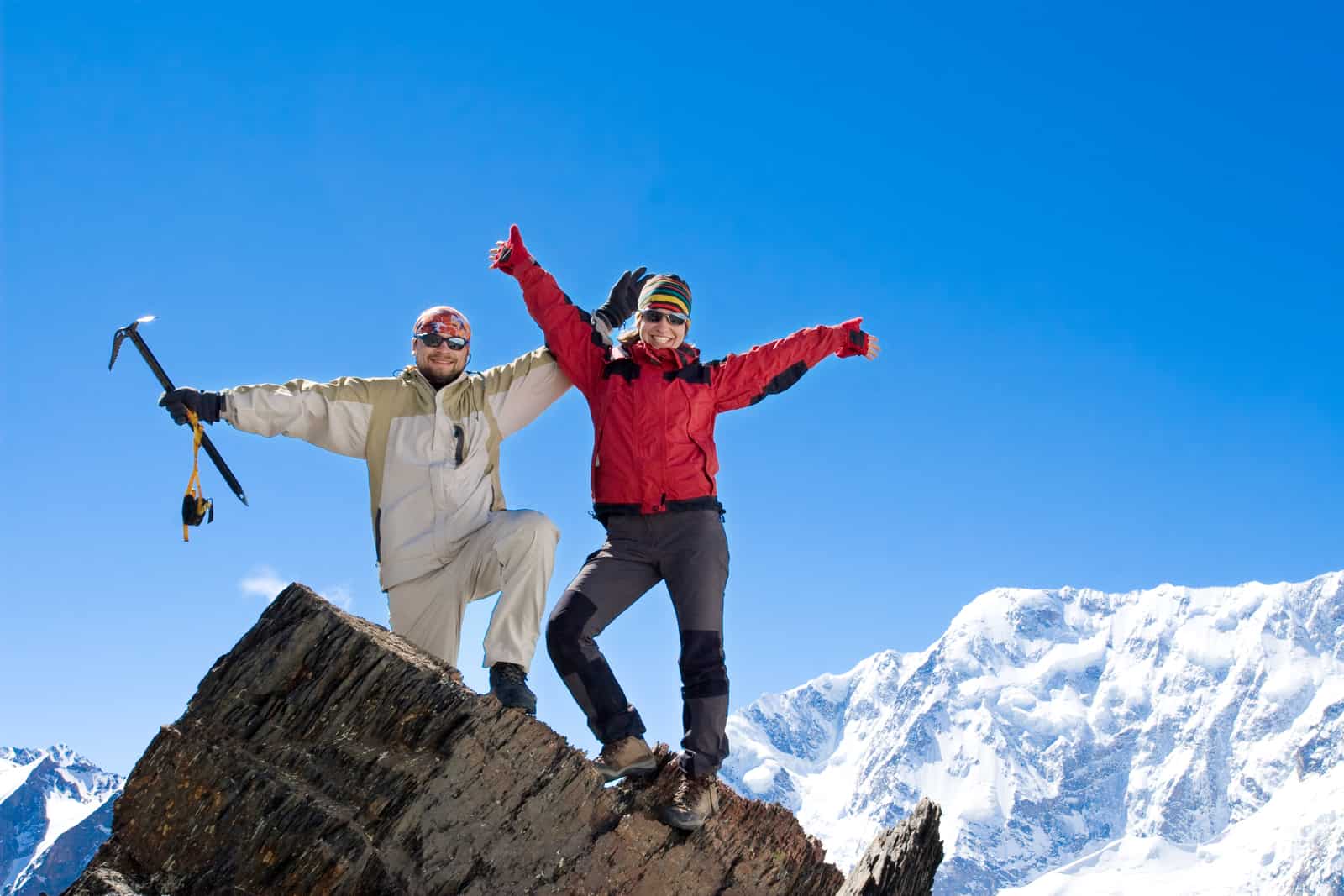
Bring a Buddy
As mentioned before, don’t attempt the mountain alone. Anything can happen, from the weather taking a turn for the worse, to a fall leaving you injured to encountering a wild animal. There’s safety in numbers and we recommend always travelling in a group with at least one experienced person.
Having others with you to encourage and push you along during tough sections is also a great way to ensure that you reach the summit and enjoy the reward of all your hard work.
Waterproofing
There are many reasons and ways in which to get wet in the mountains. Rain, river crossing, falling in a puddle, your water bottle leaking on your pack. All of these could turn your comfortable, warm and dry jacket into a soaking mess and leave you cold and damp, catching a chill.
Water
Dehydration is never fun. At higher altitudes, symptoms of dehydration could be aggravated, leading to headaches, fatigue and confusion. Always make sure that you take enough water with you and that you have the means of purifying more when needed.
Snacks
It is important to maintain your energy levels. For this reason, you should pack snacks that are nutrient-dense and lightweight. The best option is nuts, trail mix and jerky. These are easy to eat on the go, don’t spoil easily and don’t take up much space. Whatever you choose to bring along should be high in carbohydrates and protein.
If you’re going on longer excursions (more than one day), pack foods that are easy to prepare or already prepared and packaged, like single-serving, pre-packed tuna or ramen noodles. These will give you the energy you need to sustain yourself without weighing so much that you can’t carry it to the top.
Stretching
Dynamic stretching is a great way to prepare for the day’s exercise. You will warm up your muscles while getting things moving, preparing your body and mind for what lies ahead.
First Aid
Whether you’re a trained first aider or not, it is important to bring a basic medical kit and to know how to use it. Common, minor injuries you’re likely to encounter en-route include blisters, cuts and bruises, insect bites and sunburn. Having the correct treatment at hand will make handling these so much easier.
More serious injuries may include sprains (especially of ankles), broken bones or upset stomachs (usually from improper preparation of water or food). Sprains and upset stomachs are easy to deal with, but will usually require the expedition to halt while the injured or ill person recovers enough to continue. Broken bones are a bit more serious and may require contacting the search-and-rescue team for assistance.
While Climbing
Now that you know how to plan your trip and what to take with you, there are some basics you need to keep in mind during your expedition. One of the most basic and obvious is to greet people you pass on the trail. Being friendly doesn’t cost anything and makes the experience all the more pleasant for everyone involved.
Stay on the route
Getting lost is terrible. Staying on the route keeps you safe and usually away from steep crags you can’t see until you fall into them. If there’s no demarcated route, be sure to plan one and stick to the plan. Sharing this route with mountain guides before you embark on you expedition is also a safe way to ensure that people know where to start searching for you if you don’t show up at the finish line in time.
Don’t Litter
Another obvious one. If it’s not biodegradable, take it back with you. This goes for candy wrappers, toilet paper and any other waster you generate while out in the mountains. Keeping the mountain free from litter keeps it clean not only for other hikers, but also for the people and animals who live there.
Going to the Bathroom
If you need to do your business, be logical about it. Don’t do it near the trail or near a water source, since it’s likely to pollute the water and bother other hikers who pass along the same way. Take a small shovel with you to bury any residue you leave. Bring a small, sealable plastic bag for toilet paper and baby wipes, since these should not be left behind in the mountain.
Taking Pictures
Taking pictures is a great way of capturing your amazing experiences in the mountains. Be wise about it though and think of the safety aspect before you take that amazing shot. Don’t take selfies or jump shots along ridges or anywhere else you can easily fall off and get hurt.
Making Noise
Being out in the mountains and listening to nature’s sounds is one of the best feelings imaginable. This one should go without saying: leave your earphones and speakers at home. Take time to take it all in. Not only is this great therapy, but also a safety aspect. If you can’t hear what’s going on around you, you’re likely to miss amazing encounters or important warnings, like the changing weather or approaching wild animals.
After the Climb
Winding down after the climb is as important as preparation and the actual climb. Be aware that your body will probably ache and hurt due to all the exertion you’ve been through. Be gentle with it and allow yourself to recover.
The best part is the memories you now cherish and the endorphins that go with it. If the bug has bitten, you probably can’t wait to go again.
Conclusion
If you are just starting out. Take it slow. Start by tackling some of the local hills or mountains near your location. Work your way up, don’t stress and tackle the big mountains when you have no experience (or learn the hard way why you shouldn’t like I did).
Don’t spend a million on equipment, even if you can. I find that it’s wiser to start slow and then realize while going along what you do and do not need. That being said, a pair of good mountaineering boots and some weather resistant clothes goes a long way.
Finally, learn together with your friends! Tackle the mountains with someone you know or even better, get to know someone that have the same mountaineer goals as you do. It’s always much easier to learn together, and you will create great bonds with the people that share the mountains with you.
Written by Felix

About me
Hi! I’m Felix. When I’m not spending time out in the mountains, I like to write about my hobbies. That is how Mountain Homies was created. On this site, I try to gather all the juicy information about Mountaineering that I have learned since I started. Happy adventures!
Recent Posts
The 10 Largest Glaciers In The World (Length, Location & More)
In this article, we’ll have a look at the ten most massive glaciers in the world (by length, not area). Some of these are accessible for hiking and climbing, while others are not…
3 Ways to Spot and Reveal a Crevasse (And Avoid It)
So, how do you spot a crevasse and – more importantly – avoid falling into one? In this article, I will have a look at what crevasses are and how to detect them…
5 Ways of Knowing If Your Climbing Shoes Are Too Big
It has almost become a prestige among climbers to be able to boast about how small and tight climbing shoes can be used. There is therefore a lot of talk…
Related Articles
3 Ways to Spot and Reveal a Crevasse (And Avoid It)
So, how do you spot a crevasse and – more importantly – avoid falling into one? In this article, I will have a look at what crevasses are and how to detect them…
5 Ways of Knowing If Your Climbing Shoes Are Too Big
It has almost become a prestige among climbers to be able to boast about how small and tight climbing shoes can be used. There is therefore a lot of talk…
3 Clever Ways of Crossing A Crevasse
When you’re mountaineering in snow country, you will undoubtedly encounter some crevasses. These are scary, since you don’t always spot them…
Stay Up to Date With The Latest News & Updates
Join Our Newsletter
The owner of this site is a participant in the Amazon Services LLC Associates Program, an affiliate advertising program designed to provide a means for sites to earn advertising fees by advertising and linking to amazon.com.

